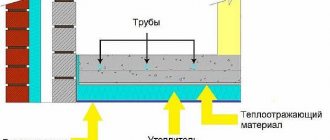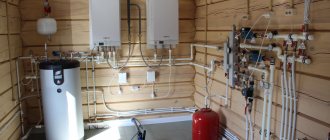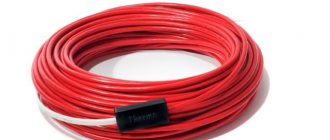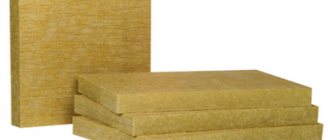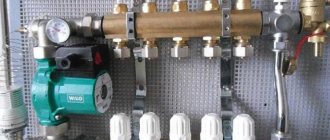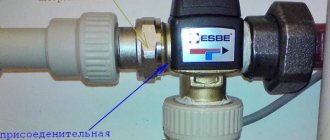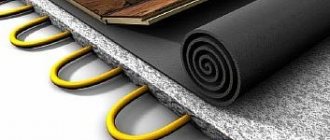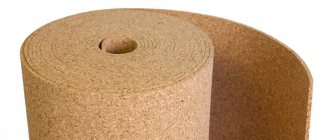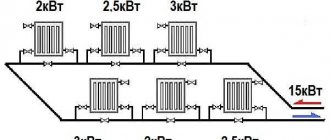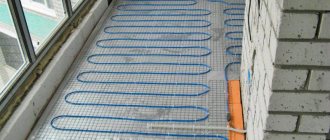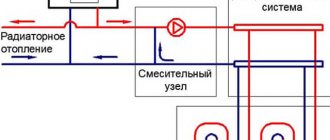Are you installing a water-heated floor system in a country house and it’s time to lay the insulating underlay? Agree that among the variety of offers of heat-insulating materials offered by manufacturers, it is sometimes not easy to make the right choice.
We will help you determine which insulation for a warm water floor is better. Together with you we will understand all the intricacies of assembling heat-insulating systems. We will examine the characteristics of popular materials and evaluate the key advantages and disadvantages.
Do-it-yourselfers will find installation instructions here. To make it easier to navigate the assortment offered by the building materials market, we have selected videos with recommendations for choosing insulation and installation.
Types of mats
A total of four types of mats are produced for installation under water-heated floors. All of them have individual characteristics and are designed for installation in specific conditions. Expanded polystyrene mats include:
- Roll backing;
- Expanded polystyrene boards;
- Polystyrene with foil;
- Expanded polystyrene mats with bosses.
The choice of insulating mat depends on the characteristics of the room and the load that will need to be withstood. Please note that the slabs have different thicknesses.
Rolled backing
All experts agree that roll backing can be called an insulating material at a stretch. The reason for this is its small thickness from 2 to 10 mm. Therefore, the scope of use of this material is quite limited.
This type of insulation is used only in cases where it is installed as an auxiliary material or if the heated floor is used extremely rarely.
It is strictly not recommended to install roll insulation over basements or other unheated areas. Their effectiveness in this case will be zero.
The roll backing is not very convenient during installation. To install it, you will need special tape, and when installing underfloor heating pipes, they must be additionally secured to the floor.
In the only justified case, it is worth using a rolled underlay for a heated floor - this is when the architectural features of the room do not allow raising the floor level.
In general, this type of insulation is used extremely rarely under heated floors and is not recommended by most experts due to its low efficiency.
Expanded polystyrene boards
Expanded polystyrene boards, which can be divided into two types, are well suited for insulating heated floors. A cheaper option is regular foam. If you choose this option, you should remember that the density of the insulation should not be less than 35 kg/m3. Such requirements must be met to ensure that the substrate will not bend or burst under the weight of the structure.
More durable, but also more expensive insulation is extruded polystyrene boards. This material has a cellular structure, can withstand loads well, and has good strength.
To obtain an even greater thermal insulation effect, a roll backing can be mounted on top of the slabs.
Each plate has special locks that facilitate the installation of insulation. If you buy insulation with markings already made, it will make it easier to lay pipes on the insulation.
Expanded polystyrene with foil
These insulating mats for heated floors are also made from polystyrene foam. They come in two types:
- Panels connected to each other by continuous foil film. During installation, such insulation is laid out over the surface;
- separate mats with special locks on the sides. When laying the slabs, they are connected to each other using grooves on the locks.
A coordinate grid is applied to such panels, allowing you to quickly navigate when laying a pipe or heating cable.
To attach the heated floor, staples or reinforcement mesh are used.
Expanded polystyrene mats with bosses
This type of insulation was specially invented for installation under heated floors. The texture is the same as polystyrene foam in slabs that have special convexities on one side, called “bobs.”
The protrusions, depending on the manufacturer, can vary greatly in shape and are located one from the other at a certain distance. This design is intended to fix the water pipe on the surface of the insulation and does not require additional fastening.
The height of the boss is 20-25 mm, which allows you to easily attach a 20 mm pipe, which is typical when laying a water-heated floor. The height of the entire slab can be 40 - 50 mm.
The slabs have connections with locks that ensure good tightness of the insulation, so any type of screed can be laid on it. Another advantage of this type of mat for heated floors is sound insulation. They allow you to reduce noise levels by up to 25 dB.
Features of laying insulation
The principle of installing a thermal insulation layer is simple, no special tools or special experience are needed, the main thing is to follow the technological process.
Watch the video on how to choose insulation:
How to choose insulation for a heated floor. Lifehack from Design.rf
Installation of polystyrene foam boards
The work of installing polystyrene foam boards under a heated water floor is as follows:
- Regardless of the type of thermal insulation product, you need to start by preparing the subfloor. It should be smooth, without cracks. If irregularities and flaws are found in the surface, they need to be repaired.
- Waterproofing measures consist of arranging a layer that protects against moisture, this can be a polyethylene film.
- Sticking damper tape around the perimeter of the room is necessary to compensate for temperature fluctuations.
- Laying insulation boards over the entire area - the sheets are fixed to the base using plastic staples or dowels; the product can be installed with glue.
- Spreading foil film and installing reinforcing mesh over the insulation.
- Installation of heating elements (pipes) - they are attached to the grid according to the planned scheme. The seams between the plates should be taped with tape, this will help retain heat.
- Pouring concrete screed over the pipeline. To ensure surface strength, it is recommended to add plasticizers to the solution. It is necessary to let the mixture harden, this will take about a month.
- The last step is the installation of the finishing coating.
For your information! It is worth considering that underfloor heating pipes with the coolant inside have significant weight, plus the screed and finishing coating, all of this together will push through the insulation over time.
To avoid this, high-strength thermal insulation is required. In addition, to strengthen the structure and distribute the load evenly, it is recommended to reinforce or lay polystyrene foam slabs with bosses. In addition, such mats facilitate the process of placing pipes and fixing them.
Laying rolled polyethylene foam
Installation work on the construction of a water-heated floor using rolled polyethylene as insulation begins with leveling and cleaning the base.
At the second stage, the heat-insulating material is prepared. This consists of cutting the heat insulator into strips of the required length using a stationery knife.
Next, the foil product is placed on the prepared base with the metallized surface facing up to ensure the best reflection of heat. The canvas should extend onto the walls, this is necessary to compensate for the expansion of the screed when heated. The insulation is attached to the floor using glue or double-sided tape. And the seams should be taped using single-sided tape.
The process of installing a water circuit on polyethylene rolls is facilitated by the presence of installation markings printed on it, which show the distance between the pipes. Heating elements on penofol can be placed in a “snail” or “snake” pattern.
Further work on the construction of water heated floors consists of installing reinforcing mesh, pouring a concrete screed and laying the floor covering.
For your information! For use in a warm water device, ALP brand penofol is recommended.
Laying mineral wool
Mineral wool cannot be crushed, so the most optimal way to install it is on the floor, with the installation of logs.
Step by step, the installation of the “pie” of a warm system with a thermal insulation substrate made of mineral wool is as follows:
- Preparation of the base is a mandatory stage of work when installing any heated floors. If the floors in the house are old, then it is better to completely remove them down to the concrete floor or rough wooden floor. The surface must be inspected for irregularities and cracks; if any are found, they are repaired.
- Laying a hydro- and vapor barrier substrate is a necessary step when using mineral insulation, as it is resistant to moisture. For these purposes, roll-type waterproofing - roofing felt, or other modern materials - is suitable. The sheets are fixed to the base using polymer or bitumen mastic. The material is laid in an overlap, the seams should be coated with mastic.
- Arrangement of wooden logs - they are attached to the subfloor over the entire area. Blocks measuring 5 by 6 cm are taken and installed on a concrete surface, secured with dowels, and on a wooden floor with self-tapping screws. The pitch between the fasteners depends on the flooring that is planned to be laid; it ranges from 40 to 80 cm. It requires making cuts in the joists to rotate the contour.
Important! If mineral wool is used as insulation, then the distance between the logs should exceed the width of the material by 1.5 - 2 cm.
- Laying insulation - mineral wool is installed in the spaces between the bars. It is necessary that it sinks at least 5 cm, as a ventilation gap is required.
- Installing a second waterproofing layer is necessary, because cotton wool is not moisture resistant. An ordinary polyethylene film is used, which is placed in a stretch on the logs and fixed with a stapler.
- Preparing the substrate for pipes - slats are used that are nailed across the logs, with a distance of 30 cm from the walls. There should be grooves between the slats in which a metal profile for laying pipes will be placed. Their size depends on the step of laying the contour.
For your information! The metal profile can be replaced with foil in which the pipe is wrapped.
- Installation of the heating circuit - heating pipes are laid into the installed profile according to the planned layout.
- Installing interior flooring - this can be chipboard or plywood.
- Finally, the floor covering is laid.
At this point, the warm floor with a thermal insulation backing - mineral wool, is ready for use.
Prices for water heated floors
The price of a water-heated floor is formed from several components:
- cost of materials (pipes, insulation, fasteners, etc.);
- cost of the pumping and mixing unit and manifold;
- work on leveling the base and pouring the top layer of screed;
- cost of installing heated floors.
On average, the price of a water heated floor when installed on a turnkey basis, along with all materials and work, will cost approximately 1,500-3,000 rubles per 1 sq. m. m.
Below is an approximate estimate for a house of 100 square meters. m., but prices for water heated floors greatly depend on the region, so it is best to enter your data there and make an independent calculation. This does not take into account the costs of installation and purchase of radiators, boiler, finishing coating and screed.
| Estimate for installation of a water heated floor system on the 1st floor. | |||||
| № | Name of material | Unit change | Qty | Price | Sum |
| 1 | Extruded polystyrene foam 5 cm | m2 | 96 | 227 | 21792 |
| 2 | Mounting grid 150*150*4 | m2 | 106 | 30 | 3180 |
| 3 | Polyethylene film 250 microns | m2 | 105 | 40 | 4200 |
| 4 | Metal-plastic pipe 16 mm | m.p. | 700 | 39 | 27300 |
| 5 | Damping tape from the substrate | m2 | 30 | 50 | 1500 |
| 6 | Valtec manifold 1″, 7 x 3/4″, “eurocone” | PC. | 2 | 1600 | 3200 |
| 7 | Fitting for connecting to the manifold (Euroconus) 16x2 mm | PC. | 14 | 115 | 1610 |
| 8 | Pumping and mixing unit | PC. | 1 | 14500 | 14500 |
| 9 | Dowels and screws | PC. | 300 | 1,5 | 450 |
| 10 | Mounting tape | m.p. | 50 | 11 | 550 |
| 11 | Other components for heated water floors | pos | 1 | ||
| Total by materials | 78282 | ||||
| Name of works | Unit change | Qty | Price | Sum | |
| 1 | Rough screed | m2 | 96 | 60 | 5760 |
| 2 | Installation of damper tape | m.p. | 160 | 60 | 9600 |
| 3 | Laying waterproofing | m2 | 100 | 60 | 6000 |
| 4 | Laying the mounting grid | m2 | 110 | 150 | 16500 |
| 5 | Pipe installation | m2 | 96 | 300 | 28800 |
| 6 | System pressure testing | m2 | 96 | 20 | 1920 |
| Total by work | 68580 | ||||
| 1 | Total by materials | 78282 | |||
| 2 | Total by work | 68580 | |||
| 3 | Total | 146862 | |||
| Overhead transportation costs | 10% | 14686 | |||
| In total, according to the estimate, installation of a water heated floor system is 1 floor. | 161548 |
Installation of warm water floors is shown in the video:
Optimal insulation thickness
It is important to make the right choice not only of the insulation model, but also of its thickness; thermal energy savings depend on this.
For your information! If the thickness of the insulation is small, then most of the heat goes under the floor, its amount is equal to the flow of warm air rising upward.
The thickness of the insulation should be selected depending on climatic conditions. It is clear that in areas with a cold climate, the layer of thermal insulation material should be larger.
The type of room located under the warm water floor also plays an important role. If this is a cold basement, or the structure is laid on the ground, then the insulation layer should be made thicker, 100 - 120 mm. When constructing a heating floor over a heated room, a sufficient thickness of 30 - 50 mm.
Installing a thermal insulation layer under a heated water floor is not a luxury, but a necessity. Incorrectly done insulation will lead to deterioration in the quality of heating and unnecessary costs.
Mixture for pouring screed
Filling a floor or screeding is a procedure that requires great care and precision. You can avoid cracking of the floor during drying and during the operation of the system by carefully observing the temperature regime and strictly following the instructions for preparing solutions.
For pouring, use ready-made self-leveling mixtures for heated floors or self-mixed ones on a concrete base.
In the first case, the mixtures are made on the basis of gypsum and require dilution with water to the consistency of sour cream. The drying time for the floor in this case is from 3 to 5 days. During this period, it is recommended to minimize air humidity.
It is better to refrain from using these solutions for floor screeding in rooms that are constantly exposed to water (bathroom, cellar).
Homemade mixtures are made based on cement. Recommended brand - M300 and above. The composition of the mixture is as follows:
- Cement - 1 part.
- Fine-grained sand - 4 parts.
- Water. Add water until the mixture reaches the consistency of dough. When adding water, constant stirring is necessary.
- Plasticizer. It facilitates screeding and is applied in concentrations recommended by the manufacturer, ranging from 1 to 10% of the volume. The criterion for the correct consistency of the mixture is the ability to form lumps from it that do not crumble or spread. If the plasticity of the composition is not sufficient, the ball cracks, which means there is not enough liquid in the mixture. If the mixture is too liquid, sand and cement must be added.
Before pouring, the perimeter of the room is covered with damper tape, which serves for sound insulation and prevents cracking of the floor when heated.
Pipes and cables are secured with rigid clamps.
The screed is produced at air temperatures from 5° to 30° (a number of professional mixtures allow installation at lower temperatures, they have a special marking).
The maximum area for one-time filling is 30 sq. m. Large spaces are best divided into sections. In places where the surface is divided into sections, protective corrugated hoses are put on the pipes.
The shelf life of the prepared solution is 1 hour, after which it cannot be used.
Filling one area is carried out quickly and in one step.
Immediately after the procedure, the mixture should be pierced in several places with an awl or a thin knitting needle to ensure the release of air bubbles. For the same purposes and additional leveling, use a needle roller or a stiff brush. The needle should be longer than the thickness of the solution layer.
Drying of homemade mixtures occurs within 20-30 days and has a number of features:
- Sudden changes in room temperature and exposure to direct sunlight are unacceptable. This is fraught with uneven drying and subsequent deformation.
It is better to cover the floor surface with plastic wrap and periodically (every few days) moisten it with liquid.
After drying, it is recommended to turn on the heating system for several hours at a moderate heat supply.
Recommended air humidity is 60-85%.
Before laying tiles, linoleum, parquet or wood flooring, the heating must be turned off.
When using materials prone to cracking and swelling, air humidity must be reduced to 65%.
The tiles are laid on tile adhesive, carpet, linoleum and laminate directly on the screed.
Self-installation of a heated water floor is possible only if you have enough time and careful and strict adherence to all instructions and rules.
We invite you to watch a video detailing the installation of water heated floors:
The need for thermal insulation
Thermal insulation is a design element that reduces heat transfer. The term can also mean materials for the implementation of such elements or a set of measures for their construction.
With the development of civilization, when the struggle for heat ceased to be so acute, massive hearths and Russian stoves were replaced by central heating radiators, and new heat-insulating materials replaced turf, moss, felt and tow. However, even now the problem of heat conservation remains acute.
- There are several reasons:
- To heat hundreds of millions of square meters of poorly insulated dwellings, it is necessary to spend a lot of money on fuel, and its reserves of fossil fuels are not endless.
- Secondly, the anthropogenic impact on the environment has recently increased, the progressive development of the “greenhouse effect”, not least caused by emissions from the combustion of coal, oil and other energy resources. Therefore, we have to look for new effective materials and methods of thermal insulation.
After the introduction of new building codes that tightened the requirements for thermal protection, the correct use of high-quality thermal insulation has become an urgent necessity. In construction today, modern heat-reflecting materials and technologies are used to save heat more effectively.
It is on this that the energy consumption of the floor in operating mode and the reduction of heat loss to a minimum depend.
- The main function of thermal insulation is:
- Preventing heat loss through the subfloor.
- Thermal insulation under an electric heated floor ensures uniform heating of all elements, with further heat transfer to the floor covering over the entire surface.
- Since high-quality heat distribution occurs, this significantly reduces energy costs.
- It creates additional sound insulation, which is especially important in an apartment building.
- If there is an unheated room or ground under the floor, then thermal insulation eliminates the penetration of moisture and cold from below.
- If the insulation for an electric underfloor heating is selected and installed correctly, then the entire underfloor heating pie turns into a closed thermal zone in which heat spreads in the desired direction and with a uniform flow.
Reducing heat loss, saving energy, preventing the appearance of mold or mildew are important tasks that can be solved by installing floor insulation. In an ordinary house, up to twenty percent of the heat can escape through the floor, since heat goes into the ground through insufficiently insulated floors.
Thermal insulation device allows not only to reduce these heat losses, but also to more efficiently use the heat capacity of the floor. If the floor has a low temperature, then moisture may condense on its surface, at the junction of floors and walls.
And this can lead to the appearance of mold and fungi, which negatively affect building structures, as well as the health of people in the room.
By properly designing the structure and insulating the floor, you can prevent these phenomena. Maximum efficiency can be achieved if you additionally insulate both the ring beam, the plinth, and the basement wall.
In other words, good thermal insulation of floors should be organized in rooms whose floors are close to the ground or in contact with outside air. Thermal insulation is also recommended for the floors of those rooms that separate heated rooms from unheated ones.
This way you can solve three problems at once. The first is to reduce heating costs, the second is to reduce environmental pollution and the third is to create comfortable conditions for people to live in the premises.
Polypropylene boards
One of the optimal options for thermal insulation of water heating, it is not afraid of elevated temperatures and humidity, and is the cheapest material in terms of cost. It is not afraid of aggressive chemical compounds and does not emit harmful substances during heating. It has low flammability and does not support open combustion. The reproduction of various microorganisms, including mold, is inhibited on the surface. It is approved for use by sanitary control organizations without restrictions. The slabs may have ready-made grooves for laying pipelines.
Polypropylene boards
Sheet polypropylene
Proper implementation of thermal insulation work
Each type of material has its own installation scheme. But any insulation is placed only on a completely flat base. Insulation from slabs using a construction chamfer is assembled simply, like a construction set. The slabs can be adjusted to size. They are easy to cut with a knife. During work, you can always change the length of the pipes or change the shape of the contour. The fixing plates are connected using mounting tape.
Features of installation step by step:
- The base under the slabs is leveled and cleared of debris. Then the slabs are laid out, attaching them with plastic brackets, either using anchor bolts or glue.
- A layer of foil is placed on top of the slabs.
- Then a reinforced mesh is laid, and pipes are laid on it.
If the base screed under the tiles has defects, then a frame of wooden logs should be mounted under the substrate. They are made from dry, even bars, the cross-section of which is 50 by 50, 50 by 100, 100 by 100 millimeters. It is recommended to lay the logs 60 centimeters apart from each other, with foam or mineral wool placed between them. The slabs must be laid without gaps; if any, they are sealed using construction foam.
Installation work on laying mats
Before you begin laying the mats, the base is equipped with film-type waterproofing. Next, a damper tape is passed along each wall and mats begin to be laid. The plates are connected using special locks. If the slabs are light in weight and thick, then they are glued and connected using staples - harpoons.
Attention! The stripes marking the edges are designed to mark the end of the heated zone and facilitate installation work. When laying mats, you cannot use metal fasteners, because this will damage the hydro- and thermal insulation.
The correct choice of heat-insulating material will increase the functionality of heated floors, so saving on the quality of insulation is not recommended
When laying mats, you cannot use metal fasteners, because this will damage the hydro- and thermal insulation. The correct choice of heat-insulating material will increase the functionality of heated floors, so saving on the quality of insulation is not recommended.
Which insulation to choose?
As mentioned above, a warm water floor requires insulation, since without it it will not function effectively. In addition, if there is thermal insulation, the system is more economical. It is important not only to know how to properly insulate a heated floor, but also how to choose a suitable heat-reflecting material.
When purchasing thermal insulation, you need to look not only at the characteristics, heat-saving properties of the material and its parameters, but also at its service life. Since a number of products with good performance often have a short service life.
Therefore, there will be a need to replace it before maintenance of the system itself is required. This is especially important in rooms with tile flooring, because it is difficult to dismantle it. In this regard, experts advise purchasing a product with a warranty period of 10 - 15 years.
Among the properties that are recommended to pay attention to:
- level of thermal conductivity;
- resistance to mechanical loads and dynamic influences;
- density indicator;
- hydro and vapor tightness.
For rooms with high ceilings, it is better to choose durable, rigid types that have a polymer base. If you are insulating a room with wooden floors, mineral wool is an excellent option, because it is fireproof.
You should not skimp on thermal insulation material when laying a heated floor. Its cost will pay off within 3 years, and if you use natural gas for heating, the payback period will be significantly reduced.
Types of insulation for heated floors
In the overall system, insulation for a heated floor performs several functions. It prevents unnecessary heat loss and ensures uniform heat distribution. In addition, any material becomes an additional noise barrier.
When viewing your options, it is important to consider the key features of heated floor insulation:
- low thermal conductivity coefficient;
- resistance to dynamic and static loads that will arise during operation;
- shape stability;
- long service life.
In addition, thermal insulation for heated floors must be fire-resistant and safe.
Manufacturers offer a wide range of insulation materials that differ in structure, thickness and characteristics. When choosing, you should take into account the characteristics of the room where the heated floor system is being installed, a possible increase in the height of the structure, and thermal insulation characteristics.
Laying roll material
Rolled insulation is placed on a base that has a flat surface and attached to it with glue or double-sided tape. You can cut the roll into strips using ordinary scissors. Taking into account the deformation of the insulation due to the expansion of the concrete screed, a layer of foil is laid, extending onto the wall.
Important! The foil is placed upward with the side that is made of metal, because in this way the heat reflection will be maximum.
Marking markings for installation on rolled material simplifies the laying of pipes by determining the distance between them. As a rule, the edges of the insulation are equipped with allowances made of a special film, which makes it possible to join two sheets together. When laying the material, you should pay attention to expansion joints. All connections must be glued using construction tape. When laying cork material, it is necessary to carefully arrange vapor barrier and waterproofing.
Profile systems
Specialized profile systems – mats made from extruded polystyrene foam – are in growing demand. Hydropellet stamping technology allows you to obtain panels of a certain size and profile. The panels may have a laminated outer covering. The profiled edges of the panels allow you to quickly install a solid heat-insulating coating. On the front side of the panels there are special shaped protrusions, between which it is easy to lay heating circuit pipes, without the need to use additional fasteners. This greatly simplifies and speeds up installation work. Profile systems are produced in the form of panels of various thicknesses - from 10 to 34 mm. Their only drawback is their high cost.
Manufacturers and prices
Many leading manufacturers offer high-quality insulation for underfloor heating. Some options are suggested in the table:
| Type of insulation | Brand | Options | Cost, rub. per m2 |
| Expanded polystyrene | Knauf Therm | 1200x600x47 mm | 500 |
| Ecopol | 1100x800x38 mm | 455 | |
| Foamshield | 1000x1000x50 | 270 | |
| Foil mineral wool | URSA (fiberglass) | roll 18000x1200x50 mm | 115-168 |
| Rockwool (basalt) | 342 | ||
| Technical traffic jam | Amorim | 1000×500×10mm | 560 |
| Penofol | Penofol | roll type A (B) | 47 (78) |
| Mylar film | Daewoo enertec | roll 1x30 m, thickness 3(5) mm | 139 |
